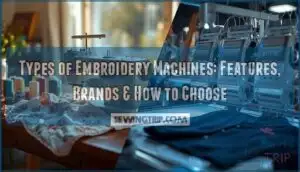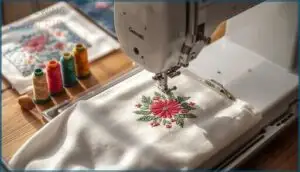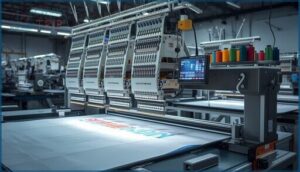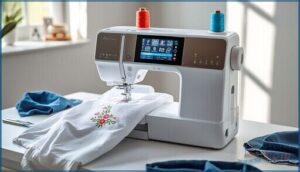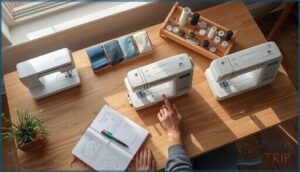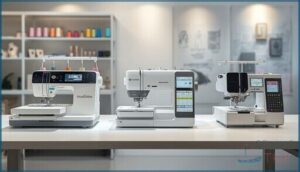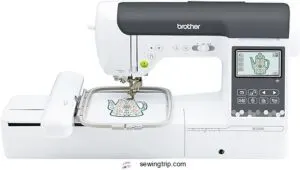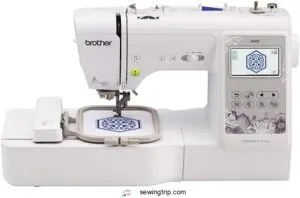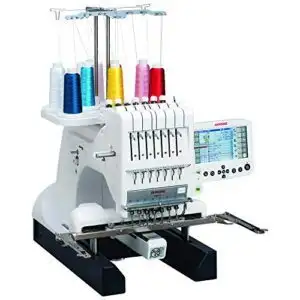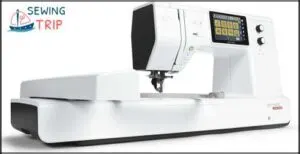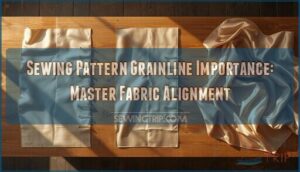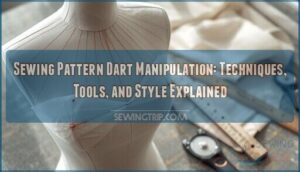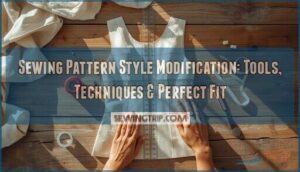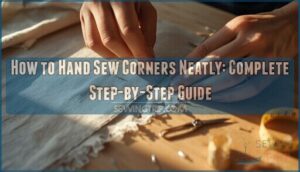This site is supported by our readers. We may earn a commission, at no cost to you, if you purchase through links.
Not long ago, switching thread colors meant stopping your machine, snipping, rethreading, and hoping you didn’t lose your place in the design. Today’s embroidery machines handle seven colors at once and stitch at speeds that would make your grandmother’s eyes water.
The difference between a single-needle home model and a multi-head industrial powerhouse isn’t just price—it’s the gap between personalizing baby blankets and running a full-scale embroidery business. Your choice depends on whether you’re stitching monograms on weekends or fulfilling orders for corporate uniforms.
Understanding how needle count, automation features, and production capacity stack up across different machine types helps you match your budget and ambitions to the right equipment.
Table Of Contents
Key Takeaways
- Single-needle machines suit hobbyists and small projects with manual color changes, while multi-needle models with 4-16 needles automate thread switching and boost speeds up to 1,200 stitches per minute for serious creators.
- Your choice between home and commercial machines hinges on production volume—home models start around $500 for weekend crafting, while industrial units exceeding $20,000 handle high-volume orders with continuous operation.
- Combination sewing-embroidery machines like the Brother SE2000 deliver dual functionality in one unit, eliminating the need for separate equipment and saving both money and workspace.
- Brother dominates the accessible market with 12% share and user-friendly features, while Tajima commands 15% of industrial production with multi-head systems built for large-scale commercial operations.
Main Types of Embroidery Machines
Choosing the right embroidery machine starts with understanding the basic types available. Each category meets different needs, from simple home projects to full-scale commercial production.
Let’s look at the main machine types you’ll encounter when shopping for your setup.
Single-Needle Embroidery Machines
Single-needle embroidery machines use one needle that you’ll rethread with each color change. They offer excellent design precision and material versatility across fabrics from silk to denim.
These single-head embroidery machines balance cost factors with professional capability, holding about 31% market share. Workflow automation features like auto-cutters reduce threading time dramatically.
Some models offer a sizable embroidery design collection for added convenience. Single-needle machines suit small businesses and hobbyists perfectly.
Multi-Needle Embroidery Machines
Multi-needle embroidery machines feature 4 to 16 needles for automatic color management, eliminating manual thread switches. You’ll appreciate stitch speeds reaching 1,200 SPM—up to 50% faster than single-needle models. AI integration now manages error detection automatically.
These machines hold 68.7% market share thanks to fabric versatility across silk, denim, and technical materials. They also offer advanced touchscreen interfaces for intuitive design customization.
Multi-needle machine features make embroidery machine comparison straightforward for serious creators.
Multi-Head Embroidery Machines
When production capacity matters, multihead embroidery machines deliver parallel processing across multiple heads. These industrial embroidery machines dominate commercial operations with automation features that include:
- 15 needles per head for extensive color variety
- 1,200 stitches per minute balancing speed with precision
- Independent head control maintaining productivity during maintenance
The Asia Pacific region holds 37.10% market share, reflecting strong industrial applications. Multihead machine features like auto-mend technology minimize downtime, while technical specs supporting 100 million stitches guarantee continuous production without design reloads.
Industrial Embroidery Machines
You need industrial embroidery machines when automation integration and production capacity become critical to your commercial embroidery business. These textile machinery systems feature computerized controls and technological advancements that handle high-volume demands. Unlike multihead embroidery machines focused on parallel production, industrial models emphasize continuous operation.
The global market reached $2 billion in 2025, with maintenance practices ensuring machines deliver consistent results across thousands of stitches daily.
Combination Sewing and Embroidery Machines
When you want both crafts without doubling your investment, combination sewing embroidery machines deliver space-saving and cost savings in one unit. These embroidery machine types merge full sewing machine functionality with design editing capabilities.
User-friendliness stands out through automatic threading and touchscreen controls. You’ll handle fabric handling from denim to silk while switching seamlessly between 250+ stitches and embroidery mode.
Combination machine features commonly include USB connectivity and built-in design libraries.
Features of Different Embroidery Machine Types
Understanding the features of different embroidery machines helps you match capabilities to your specific projects. Each machine type offers distinct advantages based on needle setup, automation level, and workspace size.
Let’s look at the key features that separate one machine from another.
Needle Configuration and Color Changes
Your machine’s needle count shapes how you handle color changes. Single-needle machines require you to stop and manually rethread for each thread color change—a process taking about a minute.
Multi-needle setups run from six to sixteen needles, each pre-threaded with different colors. This allows automatic thread switching at speeds up to 1,400 stitches per minute, keeping production moving without constant intervention.
Automation and Computerization
Modern computerized embroidery machines put sophisticated technology at your fingertips through touchscreen interfaces and built-in designs. Computer-controlled embroidery systems deliver precision that manual methods can’t match.
AI integration brings three game-changing capabilities:
- Error correction automatically detects thread breaks and skipped stitches
- Fabric recognition adjusts needle settings for different materials
- Remote operation via IoT connectivity lets you monitor production from anywhere
USB ports simplify transferring custom patterns instantly.
Embroidery Area and Hoop Sizes
Your embroidery area determines what you can actually create. Small hoops like 4×4 inches handle monograms and patches. Medium hoops around 5×7 inches work for adaptable projects. Commercial hoops reach 9×14 inches or larger for extensive designs.
Remember that the stitchable area runs slightly smaller than the labeled hoop size due to machine mechanics. Verify your hoop compatibility before buying designs to guarantee proper design placement.
Built-in Designs and Fonts
Your design library matters more than you think. Entry-level machines offer 80 to 300 builtin designs and embroidery fonts, while sophisticated models pack 900 to 1,800 options.
Design limitations appear with fixed stitch counts, but memory capacity and AI integration now enable font customization and design updates.
Most machines include 6 to 15 builtin embroidery fonts optimized for different fabric types and embroidery designs.
Accessories and Compatibility
Your accessory ecosystem determines what you can actually create. Hoop compatibility varies dramatically—Brother embroidery machines include 4×4, 5×7, and 6×10 hoops, while industrial models accept magnetic hoops up to 500mm.
Essential embroidery machine accessories include:
- Stabilizers (tear-away, cut-away, water-soluble)
- Thread types (rayon and polyester for embroidery)
- Needle selection (standard 75/11 for most projects)
- Software integration (USB ports and wireless adapters)
Multi-needle machines need specific needle sets and color-coded changers for automatic transitions.
Choosing The Right Embroidery Machine
Picking the right embroidery machine isn’t about grabbing the fanciest model on the shelf. It’s about matching your actual needs with what the machine can deliver.
Let’s walk through the key factors that’ll help you make a smart choice.
Home Vs. Commercial Use
Before you dive into types of embroidery machines, consider your production volume and skill requirements. Home embroidery suits hobbyists with limited projects, while commercial embroidery accommodates high-volume orders for businesses.
Design complexity matters too—commercial machines tackle intricate patterns faster. Maintenance needs differ greatly between the two.
Your business viability depends on matching machine capabilities to your embroidery machine purchase considerations and actual workload demands.
Cost and Value Considerations
Once you’ve determined whether home or commercial use fits your needs, you’ll face pricing factors that range dramatically. Single-needle embroidery machines start around $500, while industrial models exceed $20,000. Your embroidery machine cost vs value analysis should weigh these elements:
- Needle count directly affects efficiency and embroidery machine purchase considerations
- Stitch speed determines production capacity and ROI analysis outcomes
- Accessory impact includes hoops, stabilizers, and software costs
- Market trends show used machines offer savings up to 90%
- Embroidery machine brands like Brother and Tajima affect long-term value
Multi-needle machines priced at $5,500 can generate revenue within months for small businesses.
Space and Setup Requirements
Beyond budget, your workspace ergonomics and spatial requirements matter just as much. Single-head embroidery machines need roughly 6.25 square feet, while commercial units demand 120 square feet for the floor footprint alone. Factor in electrical needs—many industrial machines require dedicated 240V circuits.
Your home-based embroidery business can thrive in a spare bedroom with proper storage solutions and accessibility planning for efficient embroidery machine setup.
Ease of Use and Learning Curve
Your skill level shapes which machine you’ll master fastest. Single-needle embroidery machines with straightforward interface designs and built-in tutorials let you complete your first project in under six hours. Beginner-friendly models featuring automatic threading cut setup time by 30%, while instruction manual clarity and error prevention systems reduce frustration by 68%.
Multi-needle units demand 50% more training time, so match the machine’s complexity to your current expertise and available training resources.
Software and Connectivity Options
How easily can you get designs onto your machine? Look for models supporting WiFi or USB design uploads, plus compatibility with digitizing software like Wilcom or Hatch. Wireless transfer via apps speeds your workflow by 40%. IoT integration permits remote monitoring, while cloud libraries offer instant design access.
Computer interface quality and bundled software determine your creative flexibility and device connectivity options.
Popular Brands in Embroidery Machines
When you’re ready to invest in an embroidery machine, the brand you choose matters as much as the features. Some companies have built their reputation on reliable home machines, while others dominate the industrial space with heavy-duty performance.
Let’s look at the top brands that consistently deliver quality across different price points and user needs.
Brother Embroidery Machines
Brother embroidery machines claim about 12% of the global market share, making them a household name for good reason. You’ll find their compact designs perfect for small businesses and home use, packed with sophisticated computerized features that simplify your workflow.
- AI integration and cloud-based software improve your design convenience
- Combination sewing functions expand your creative possibilities
- Strong distribution network across the U.S. and Europe ensures accessibility
- Interfaces that are easy to use lessen your learning curve considerably
Janome Embroidery Machines
Janome embroidery machines stand out with seven-needle models that handle semi-professional and light commercial work across 100+ countries. You’ll appreciate their touchscreen interface and extensive design libraries that make pattern selection straightforward.
Janome durability comes backed by strong warranties and customer support networks, which explains their steady market share growth. When choosing embroidery machines, their reliability gives you confidence for long-term use.
Bernina and Bernette Models
Bernina commands the high-end embroidery machines market with professional-grade stitching quality that sets industry standards. Their machines shine in fabric handling precision, while the Bernette line creates opportunities for entry-level models at budget-friendly prices.
Here’s what makes Bernina embroidery machines worth considering:
- Mobile integration connects your smartphone to design customization tools
- Desktop apps expand your creative control over pattern management
- Strong revenue growth reflects expanding North American product lines
- Luxury sewing-embroidery combos deliver multi-function versatility
- High-end embroidery machine features support complex project demands
Tajima Industrial Machines
Tajima leads industrial machines with a commanding 15% market share that speaks to decades of reliability. Their multi-head systems reach stitch speeds up to 1,200 stitches per minute, transforming large-scale production workflows through real-time tracking technology.
| Feature | Specification |
|---|---|
| Market Position | 15% global share in textile machinery |
| Stitch Speed | Up to 1,200 stitches/minute |
| System Type | Multi-head and multihead machines |
| Service Support | Substantial infrastructure across Asia-Pacific, Europe, North America |
You’ll find production tracking and quality controls built into their embroidery machines, backed by extensive service infrastructure wherever your business operates.
ZSK Commercial Machines
ZSK stands out through multi-head systems designed for your commercial embroidery business, commanding 68.7% of the market where precision matters most.
Their TWMXC series brings cloud connectivity and magnetic hooping that cut setup errors dramatically.
You’ll find IoT integration and AI improvements driving operational efficiency, while their multihead machines scale with your production demands—perfect for industrial machines requiring both flexibility and sustainability.
Top Embroidery Machines for Every Need
Now that you know the major brands, let’s look at specific machines that offer real results.
Each model below suits different skill levels and project types. Whether you’re starting out or scaling up your embroidery work, these machines offer proven performance.
1. Brother SE2000 Sewing Embroidery Machine
You can think of the Brother SE2000 as a Swiss Army knife for fabric crafters. This combination sewing embroidery machine blends 241 sewing stitches with 193 embroidery designs and a 5×7-inch magnetic hoop.
The touchscreen makes editing simple, while wireless connectivity lets you send patterns directly from your phone via the Artspira App. Brother embroidery machines like this deliver solid stitch quality at 650 SPM in embroidery mode.
Its beginner friendliness and embroidery machine features make it ideal for home users exploring both crafts.
Best For: Hobbyists and intermediate sewists who want to explore both garment sewing and embroidery without buying two separate machines.
- Wireless connectivity and the Artspira app make transferring and creating custom designs super convenient without fumbling with USB drives.
- The 5×7-inch embroidery field with a magnetic hoop gives you enough space for larger projects like tote bags and decorative pillows.
- Color sorting and automatic jump stitch trimming save you time by organizing thread changes and cleaning up loose threads automatically.
- The machine doesn’t include a carrying case, and at over 20 pounds, moving it around can be a hassle.
- The automatic threading feature takes some practice to get right and can be finicky when you’re starting out.
- If you want full access to the Artspira app’s features, the ongoing subscription cost adds up over time.
2. Brother SE1900 Sewing and Embroidery Machine
If you want something smaller than the SE2000 but still capable, the Brother SE1900 hits that sweet spot. This combination sewing embroidery machine packs 240 stitches and 138 embroidery designs with a 5×7-inch field—plenty of room for most home projects.
The 3.2-inch touch screen lets you preview and edit before stitching, while automatic thread handling cuts down on busywork.
Brother embroidery machines like this balance design capacity with stitching capabilities at 850 SPM, making it reliable for creative work without taking over your workspace.
Best For: Sewers and crafters who want a capable combination machine with a generous embroidery field without committing to a professional-grade model.
- 5×7-inch embroidery field gives you room to work on larger designs without constant rehooping
- 240 built-in stitches and 138 embroidery designs offer plenty of creative options right out of the box
- Automatic needle threading and thread cutting handle the tedious parts so you can focus on creating
- No extension table included, so you’ll need to buy one separately for bigger sewing projects
- 120-volt power means it won’t work outside the US without a converter
- Limited hoop size options might feel restrictive if you want to tackle really large embroidery work
3. Brother SE600 Sewing Embroidery Machine
The Brother SE600 drops the price even lower while keeping machine versatility intact. You get 103 sewing stitches and 80 embroidery designs with a 4×4-inch embroidery area—tight but workable for patches and monograms. Speed efficiency runs at 710 SPM for sewing and 400 for embroidery.
The 3.2-inch touchscreen facilitates design customization through USB imports. At under $300, it’s strong market value for beginners testing both crafts.
User friendliness shines with automatic threading and simple hoop sizes that don’t intimidate newcomers.
Best For: Beginners and casual crafters who want to explore both sewing and embroidery without a huge upfront investment.
- Affordable price under $300 makes it accessible for newcomers testing whether they’ll stick with the hobby long-term.
- Combines 103 sewing stitches and 80 embroidery designs in one machine, so you don’t need separate equipment for different projects.
- Automatic needle threader and simple touchscreen interface remove common frustrations that trip up first-time users.
- The 4×4-inch embroidery area limits you to smaller designs like patches and monograms, requiring multi-hooping for anything larger.
- Bulky dimensions and 12-pound weight make storage tricky if you’re working with limited space.
- Not built for heavy commercial use, so frequent or intensive projects may wear it down faster than industrial-grade machines.
4. Janome MB-7 Seven Needle Embroidery Machine
The Janome MB-7 eliminates thread-change hassles with its seven-needle system, allowing users to work through complex multicolor designs without stopping. This feature has made it a workhorse for home-based embroidery businesses. The machine’s jumbo bobbin design holds 40% more thread than standard spools, significantly reducing downtime between refills.
Stitch quality remains consistent at 800 SPM, and workflow efficiency is enhanced by the ability to wind bobbins independently during active embroidery. The market reception highlights its reliability and quiet operation, positioning it as a valuable tool for serious hobbyists looking to scale production.
At $5,999, the Janome MB-7 is tailored for those ready to take their embroidery endeavors to the next level.
Best For: Home-based embroidery businesses and serious hobbyists who need to handle high-volume, multicolor projects without constant thread changes.
- Seven-needle system lets you breeze through complex designs without stopping to swap threads manually.
- Jumbo bobbin holds 40% more thread than standard ones, so you spend less time refilling and more time stitching.
- Quiet operation at 800 stitches per minute with consistent quality makes it reliable for professional results.
- Some users report frustrating issues with thread tension and breakage during use.
- At nearly $6,000, it’s a significant investment that might not make sense for casual hobbyists.
- Threading the bobbin can be tricky, and customer support has been hit-or-miss according to reviews.
5. Bernette B79 Sewing and Embroidery Machine
For users seeking versatility without breaking the bank, the Bernette B79 delivers both sewing and embroidery capabilities at approximately $1,580. This combination sewing embroidery machine features a 5-inch touchscreen navigation system and includes 500 stitches alongside 208 embroidery designs.
The Stitch Designer tool unlocks creative freedom, while dual feed technology ensures even fabric handling. Hoop detection automatically recognizes three hoop sizes, and the 260 x 160 mm embroidery area accommodates diverse projects.
User reception highlights its sturdy construction and value, making it a smart pick among Bernina embroidery machines for home embroiderers.
Best For: Home sewers and embroidery hobbyists who want a reliable combo machine with room to grow creatively without spending over $2,000.
- 500 stitches and 208 embroidery designs give you tons of creative options, plus the Stitch Designer lets you customize patterns however you want.
- Dual feed system and automatic hoop detection make fabric handling smoother and take the guesswork out of switching between projects.
- Sturdy build quality that punches above its price point, with a 5-inch touchscreen that’s way easier to navigate than old-school button panels.
- Some users struggle with the menu system and settings, and the manual doesn’t always fill in the gaps, so you might need to hunt down tutorials online.
- Not built for heavy-duty fabrics or really thick layers, so if you’re working with canvas or multiple quilt layers, it might not hold up.
- Accessories and replacement parts can be tough to track down, and the machine needs regular maintenance to keep running smoothly.
6. Brother PE535 Embroidery Machine For Beginners
If you’re stepping into embroidery for the first time, the Brother PE535 offers beginner friendliness without overwhelming complexity. Priced under $500, this embroidery machine delivers market affordability while providing 80 built-in embroidery designs and nine font styles.
Its 3.2-inch touchscreen simplifies design editing, and the 4×4-inch hoop accommodates most starter projects. With 400 stitches per minute stitching performance and automatic needle threading, you’ll achieve quality results quickly.
The practical usability extends through USB connectivity for importing custom designs, making it ideal for personalizing gifts and home décor.
Best For: Beginners who want an affordable, user-friendly embroidery machine for personalizing gifts, clothing, and home décor without the steep learning curve.
- Priced under $500, making it one of the most affordable embroidery machines with solid features and quality stitching for home users.
- Intuitive 3.2-inch touchscreen with built-in video tutorials and help guides makes learning embroidery straightforward even for complete beginners.
- Comes with 80 built-in designs, 9 fonts, and USB connectivity for importing custom designs, giving you plenty of creative options right out of the box.
- Limited to embroidery only, so you’ll need a separate sewing machine if you want to do regular stitching or alterations.
- The 4×4-inch hoop size restricts you to smaller projects and won’t accommodate larger designs without splitting them up.
- Additional costs add up quickly since you’ll need to buy embroidery thread, stabilizer, and potentially expensive digitizing software for advanced customization.
Frequently Asked Questions (FAQs)
How many types of machine embroidery are there?
Think of embroidery machines as tools on a spectrum. You’ll find three main embroidery categories: free-motion manual machines, Cornely hand-guided systems, and computerized models that vary in automation levels and design limitations.
Can an embroidery machine also sew?
Combination sewing embroidery machines handle both tasks. Most single-needle models offer dual functionality, letting you switch between projects easily. Multi-needle machines focus on embroidery only and lack regular sewing features.
Can Cricut do embroidery?
Cricut machines can’t stitch embroidery automatically. They draw washable patterns on fabric for manual stitching.
Pattern transfer works best with simple designs on cotton or linen, but design complexity and material compatibility have clear limitations.
What is the difference between an embroidery machine and a monogramming machine?
There’s no real difference. Monogramming machines are simply embroidery machines specialized for stitching text and initials.
Any embroidery machine can handle monogramming, but dedicated units offer limited embroidery fonts and design complexity.
Can an embroidery machine be used for regular sewing?
Some embroidery machines can handle regular sewing tasks, especially combination sewing embroidery machines like the Brother SE
These combo machines offer both embroidery and standard sewing functions, while standalone embroidery-only models usually can’t perform traditional sewing.
How do I get my garment onto my hoop?
Select the right hoop size for your design. Center the garment using marks or rulers.
Place stabilizer beneath the fabric. Secure it with proper tension—drum-tight but not overstretched—to maintain fabric stability and prevent distortion.
What tools and accessories do I need besides my embroidery machine?
Having the machine is just the tip of the iceberg. You’ll need hoop sizes that match your embroidery designs, various stabilizer types, proper needle selection, quality thread types, and software needs for creating patterns.
How do I position my garment on or in the hoop so that the design is not crooked?
Mark your garment’s center with chalk or tape before hooping. Align the hoop’s grid or notch precisely with the machine.
Check tension control and use stabilizers.
Test stitching on scrap fabric ensures proper alignment.
Where can I find embroidery files to stitch out on my embroidery machine?
You can download embroidery design files from online marketplaces like Etsy, EmbDesignTube, and Embroidery Library. Many offer free downloads, paid designs, and custom digitizing services.
Check file compatibility with your machine’s USB port before purchasing.
What maintenance do embroidery machines require regularly?
You might think embroidery machine maintenance is tedious, but it’s simpler than you’d expect. Daily cleaning removes lint buildup.
Weekly tasks include lubricating moving parts.
Professional servicing every six to twelve months keeps machines running smoothly.
Conclusion
The right machine doesn’t just follow the thread—it sets the pace for your entire embroidery journey. Whether you’re testing the waters with a single-needle combo or scaling up to multi-head production, matching your goals to the right types of embroidery machines determines how quickly you move from concept to finished piece.
Start with what fits your space and budget today, then upgrade as your skills and order volume demand more speed and capacity.
- https://www.brother-usa.com/home
- https://www.janome.com/?id=us
- https://www.bernina.com/en-US/Home-United-States
- https://www.maggieframes.com/blogs/embroidery-blogs/multi-color-embroidery-machine-buyers-guide-features-comparisons-efficiency-tips
- https://www.aquadigitizing.com/multi-needle-embroidery-machine-features-benefits-best-models/

